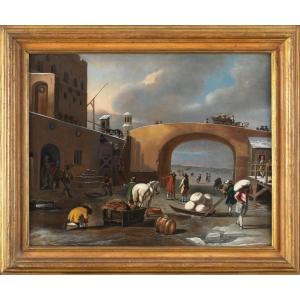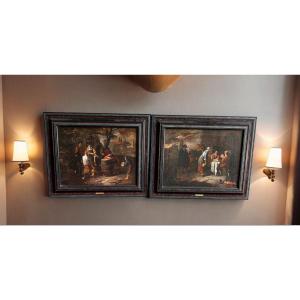In the cozy atmosphere of the corner of a guardhouse or a tavern, our young page, straight out of the world of David Teniers and whose features are recognizable among a thousand other figures, puts away the harness and armor soldiers he serves. This subject, treated many times by Teniers (Corps de garde, 1642, at the Hermitage Museum, Le Page in the guard room, around 1640, at the Gemäldegalerie Alte Meister in Dresden or Corps de garde at the Dulwich Picture Gallery of London), shows with a certain poetry the harsh condition of men during the Golden Age. Rather than illustrating their feats of arms, he chose to paint their attributes in a peaceful interior. Thus, breastplates, gorgets, gauntlets and feathered helms accumulate alongside a saddle and a bit, the knights probably having kept their weapons close to them. By reproducing in his youth the paintings of the greatest Flemish artists, Teniers acquired great ease and assimilated the best technical processes. Thus he becomes a master in the art of glazing and our composition is the perfect illustration of this. In shades of brown, ocher and gray, a scene where the darkness is disturbed by a few luminous entrances is presented to our gaze.
We have chosen to present this painting to you in a frame with an inverted profile in blackened wood.
Dimensions: 37 x 31 cm – 53 x 48 cm with the frame
Sold with inoice and certificate
Biography: David II Téniers known as the Younger (Antwerp 1610 - Brussels 1690) is the son of David I Teniers the Elder, painter and friend of Peter Paul Rubens. The eldest of six children, he began painting at a very young age in his father's studio. His brothers Julien, Théodore and Abraham follow the same path. Young David ventured for a time to copy the greatest Flemish and Italian masters, which completed his knowledge in a happy way. He gained great ease in composition, assimilated the best technical processes and acquired a speed of execution that has become legendary. A master in genre scenes that take place in cottages or inns, he paints a multitude of scenes of drinking and smoking, loutish conversations and gallant companies. By first marrying Anne Brueghel, daughter of Jan Brueghel de Velours, he secured great respect and became a notable person in the city of Antwerp. Like the rich Antwerp bourgeois, he rented a rural manor in Perck: Dry Toren (three towers in French) whose silhouette he never tires of painting in the background of his paintings and where he likes to play lord. Confident of his talent, legend has it that he could have uttered these words: “I get my genius from nature, my taste from my father, and my perfection from Rubens”.
Bibliography: Vermoelen, (Maria Huibert) John, Historical notes on David Teniers and his family, Belleuvre and Dolbeau, 1870 Peyre, Roger, David Teniers, critical biography, 1913 Bocquet, Léon, David Téniers, Editions Nilsson, 1924 Klinge margret, Waterfield Giles, Methuen-Campbell James, David Teniers and the Theater of Painting, exhibition catalog at the Courtauld Institute of Art Gallery, 2006




































 Le Magazine de PROANTIC
Le Magazine de PROANTIC TRÉSORS Magazine
TRÉSORS Magazine Rivista Artiquariato
Rivista Artiquariato